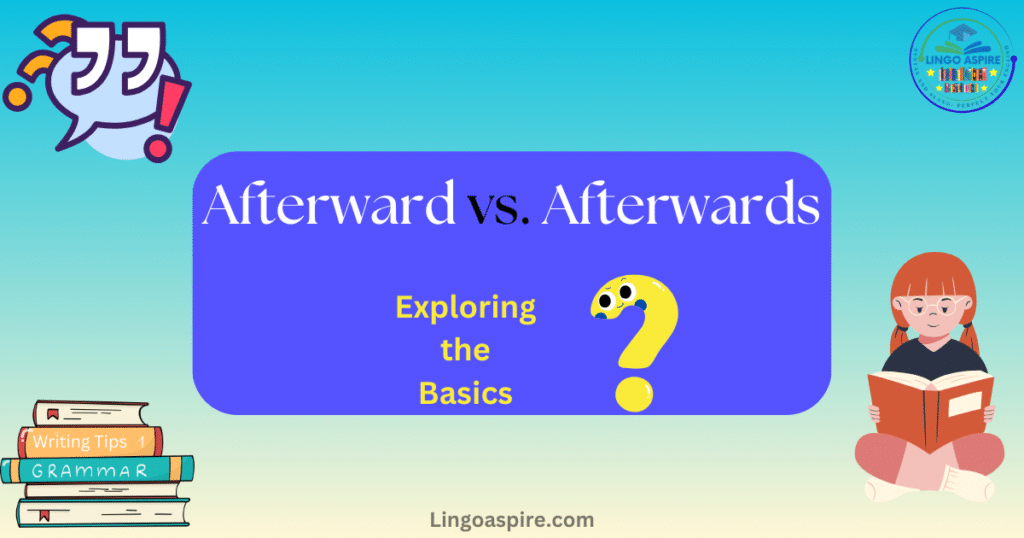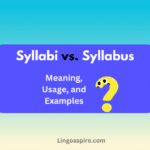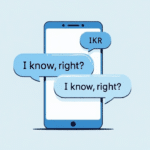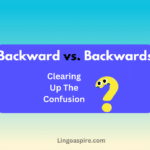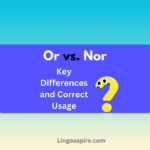In the realm of English grammar, few word pairs cause as much mix-up as afterward vs. afterwards. Both words suggest a sense of something occurring after a particular event or time. Yet, their usage often stirs confusion among writers and speakers striving for grammatical precision. This blog post delves deep into the nuances of these terms, providing clear guidelines on their appropriate usage, and illuminating their historical backgrounds to enrich your understanding and application in daily communication.
Exploring the Basics of Afterward vs. Afterwards
At the core, afterward vs. afterwards are adverbs, meaning they describe when, how, where, or to what extent an action happens. Both terms are used to indicate that something happens after a point in time or another event, essentially serving the same functional purpose. However, their usage is slightly tinted by geographical language norms which we’ll explore further.
Afterward vs. Afterwards: Differences
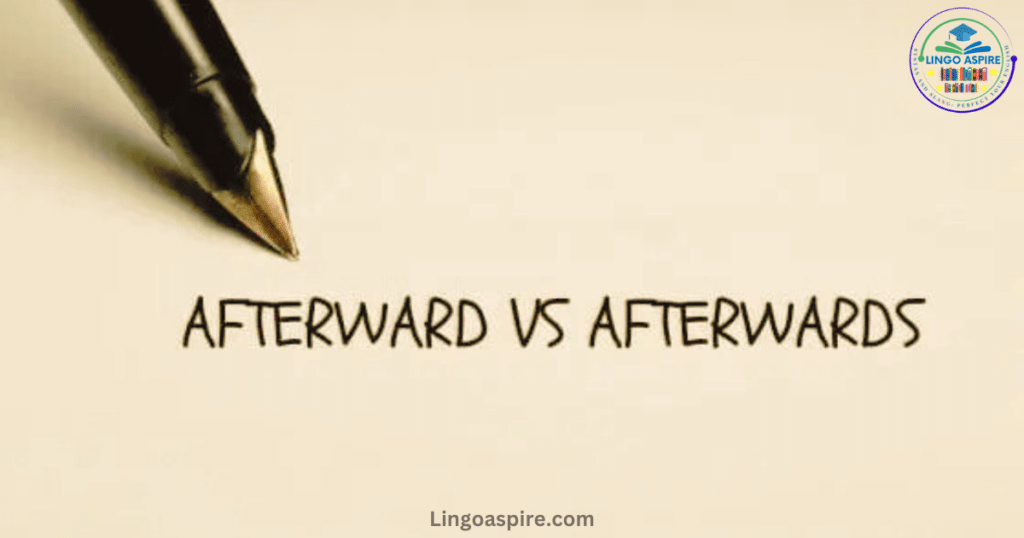
The differences between afterward vs. afterwards are subtle, mostly revolving around regional preferences and slight variations in usage. Here’s an exploration of these differences:
- Regional Usage:
- American English: “Afterward” is more commonly used in American English. It is considered standard and is preferred in both spoken and written language across the United States.
- British English: “Afterwards” is more frequently used in British English. It appears often in both formal and informal contexts throughout the UK and other regions influenced by British English norms.
- Formality:
- While both forms are acceptable in formal and informal contexts, “afterwards” might carry a slightly more formal tone, particularly in British English. This perception can influence the choice in academic writing or professional documents where a more formal tone is desired.
- Grammatical Consistency:
- Some style guides and grammar experts argue for consistency in adverbial forms. In this sense, “afterwards” aligns with other similar adverbs that end in -s, like “always” and “sometimes.” This consistency can be aesthetically or stylistically pleasing in certain texts.
- End of Sentence Usage:
- Both “afterward” and “afterwards” can be used at the end of sentences, but “afterward” might appear slightly more frequently in this position in American English. For example, “We discussed the issue; she apologized afterward.”
- Combination with Other Words:
- “Afterwards” may sometimes appear in phrases where it is combined with prepositions or conjunctions, particularly in more complex sentence constructions typical of formal British English, e.g., “Shortly afterwards, the meeting commenced.”
The primary takeaway regarding “afterward” versus “afterwards” is that the choice between them often boils down to regional preferences and the slight nuances in formality and sound. Both are correct and function similarly in conveying temporal sequence, but writers should consider their audience and regional language norms when deciding which to use.
Usage Across Different English Variants
The primary distinction between “afterward” and “afterwards” lies in their usage across different forms of English. “Afterward” is the preferred form in American English, marked by its concise and direct style. On the other hand, “afterwards” is more commonly used in British English and carries a slightly more formal tone. This variance reflects not just a linguistic preference but also cultural nuances in language use within different English-speaking communities.
Grammatical Deployment
Understanding how to use “afterward” and “afterwards” correctly involves looking at their placement and function in sentences. Both words can typically be found at the end or the beginning of a sentence. For example:
- “We went for ice cream; afterward, we went home.”
- “Afterwards, we decided to watch a movie.”
These examples show how each word can effectively convey the sequence of events, although the choice between them might depend on the writer’s or speaker’s dialect preference.
Historical Insights and Evolution
The words “afterward” and “afterwards” have both been in use for centuries, originating from the Old English word “æftanweard.” This term evolved into “afterward” to denote the direction of “back” or “behind.” Over time, the variant “afterwards” emerged, adding an -s which is common in adverbial formations in English, such as “always” or “besides.” This historical perspective helps to understand that both forms have been equally valid and rich in heritage.
Practical Examples in Modern English
To illustrate the use of “afterward” and “afterwards” in various contexts, here are some examples that highlight how each can be employed effectively in sentences:
Examples of “Afterward”
- Narrative Usage:
- “We watched the sunset from the beach; afterward, we went for a walk along the shore.”
- Formal Report:
- “The meeting was convened to discuss budget allocations. Afterward, the committee drafted a proposal.”
- Instructional Context:
- “Complete the first part of the form and submit it to the office. Afterward, ensure you receive a confirmation email.”
- Casual Conversation:
- “I had lunch with some old friends, and afterward, we went shopping.”
- Literary Writing:
- “He confessed his doubts, hoping for relief; the silence afterward was telling.”
Examples of “Afterwards”
- Narrative Usage:
- “She gave a stirring speech. Afterwards, many people approached her to express their admiration.”
- Formal Document:
- “The participants completed the survey. Shortly afterwards, the results were analyzed by the research team.”
- Instructional Context:
- “Once the software is installed, reboot your computer. Afterwards, you can start using the new application immediately.”
- Casual Usage in British English:
- “We had tea in the garden, and afterwards, we played some cards.”
- Literary Usage:
- “The storm raged through the night; the calmness that followed afterwards was a stark contrast.”
These examples demonstrate that “afterward” and “afterwards” are largely interchangeable, with “afterward” more commonly used in American English and “afterwards” preferred in British English contexts. Each fits naturally into a variety of sentences, serving to clarify the sequence of events or actions.
When to Use Which: A Practical Guide
Choosing between “afterward” and “afterwards” doesn’t have to be complicated. If you’re writing for an American audience or following American English guidelines, “afterward” is your best bet. Conversely, if your audience is predominantly British, or you align with British English standards, “afterwards” will be more appropriate. Awareness of your audience’s expectations plays a crucial role in this choice.
Uses of Afterward vs. Afterwards
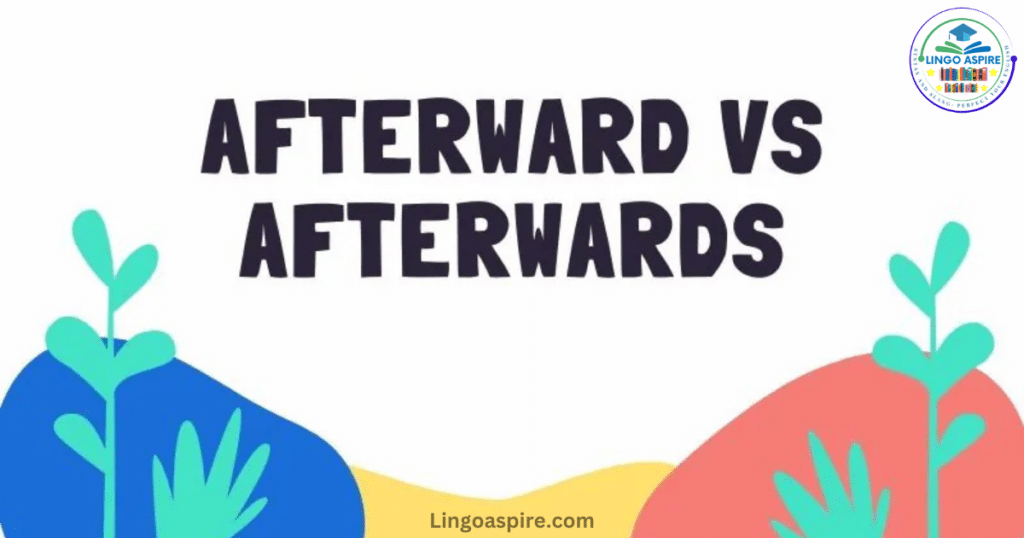
The terms “afterward” and “afterwards” are primarily used to indicate that something happens after a specific point in time or event. Here’s a breakdown of their typical uses:
- Temporal Sequence: Both “afterward” and “afterwards” are used to describe an event that occurs following another event. They help in laying out a sequence of actions or events in a narrative or explanation.
- Narrative Transition: These adverbs are useful in storytelling or descriptive writing, where they serve as transitional markers to move the narrative from one event to the next.
- Formal and Informal Speech: “Afterward” is more commonly used in American English and tends to appear in both formal and informal contexts. “Afterwards” is preferred in British English and is also suitable for both formal and informal uses but might carry a slightly more formal tone.
- Academic and Professional Writing: In academic or professional documents, these words are used to structure arguments or describe processes in a logical order. For example, in a research paper, a scholar might detail the steps of a study and use “afterward” or “afterwards” to describe what was done following an experiment or observation.
- Daily Conversation: In everyday speech, these terms are often used to recount events. For example, someone might say, “We went to the movie, and afterward, we grabbed dinner.”
- Instructions and Manuals: In guides and manuals, “afterward” or “afterwards” can be used to instruct the reader to perform a task following the completion of another, ensuring clear and sequential instructions.
These uses demonstrate the flexibility and utility of “afterward” and “afterwards” in various contexts, from casual conversation to formal writing, making them indispensable tools in the English language for expressing temporal sequences.
Synonyms and Variants
Here is a table listing synonyms and variants for afterward vs. afterwards, providing alternatives that can be used to vary language or adjust the tone of writing:
| Word/Phrase | Similarity | Contextual Use |
|---|---|---|
| Subsequently | Close | Often used in formal texts. |
| Later | General | Suitable for informal and spoken language. |
| Then | General | Common in narratives and instructions. |
| Thereafter | Formal | Used in formal or literary contexts. |
| Following this | Formal | Prefers a formal narrative style. |
| Subsequent to | Very Formal | Used in very formal or technical documents. |
This table provides a range of alternatives that share similar meanings with “afterward” and “afterwards” but are suited to different styles and contexts of writing. Each term has its nuance, making it important to choose the one that best fits the intended tone and audience of your text.
Conclusion
Whether you choose afterward vs. afterwards, the key is understanding the context in which you’re writing and the preferences of your audience. Both words offer a rich way to express sequence and time in narrative and expository writing, each backed by a long history of usage. By mastering the subtle differences, you can enhance your writing’s clarity and stylistic precision, ensuring that your message is not only heard but also felt in the way you intend.
Sources
- Merriam-Webster Dictionary: Provides definitions and examples of “afterward” and “afterwards,” detailing differences in usage across American and British English.
- Oxford English Dictionary (OED): Offers an extensive history of both words, tracing their etymology and changes in usage over time.
- Grammarly Blog: Discusses common grammatical dilemmas, including the difference between “afterward” and “afterwards,” providing modern usage examples and practical writing tips.
- BBC Learning English: Features explanations of differences in English usage worldwide, including articles and guides on commonly confused terms like “afterward” and “afterwards.”

